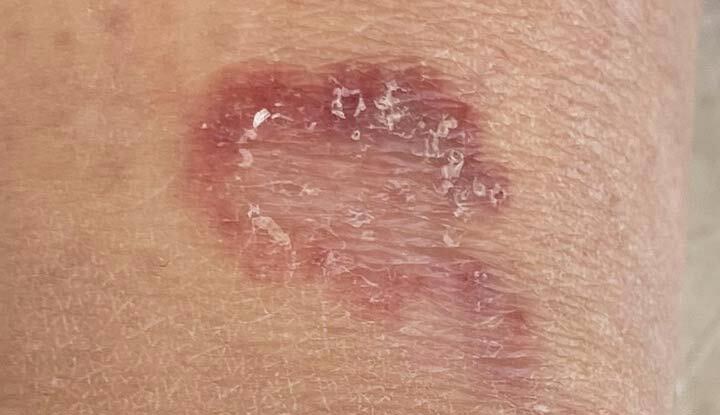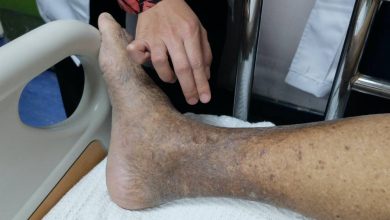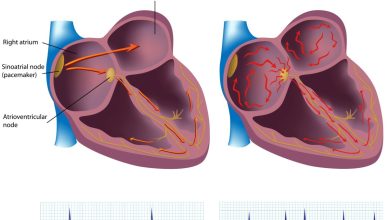Granuloma Annulare Symptoms, Causes, Diagnosis and Treatment

What is Granuloma Annulare?
Granuloma annulare is a benign (not harmful), often chronic (long-lasting) skin disorder. Inflammation in your skin causes a raised, discolored rash or lumps under your skin. In most cases, rashes form on your hands, feet, forearms and elbows.
What are the types of Granuloma Annulare?
There are five main types of granuloma annulare. It’s possible to develop more than one type of granuloma annulare at the same time.
- Localized granuloma annulare. Localized granuloma annulare is the most common form of granuloma annulare. It causes a circular rash on your skin limited to one area.
- Generalized (disseminated) granuloma annulare. Bumps develop over a larger area of your skin, like your whole forearm, instead of a smaller, more concentrated rash.
- Subcutaneous granuloma annulare. Lumps develop under your skin.
- Perforating granuloma annulare. Painful bumps form on your hands and fingers.
- Patch granuloma annulare. Flat areas of rash form in patches on your skin.
Who does Granuloma Annulare affect?
Granuloma annulare most commonly affects children and young adults, though it may affect people of all ages. It affects women twice as much as men.
You may be more likely to have granuloma annulare if you have diabetes, especially Type 1 insulin-dependent diabetes.
You may also be more likely to have granuloma annulare if you have a thyroid disease, including thyroiditis, hypothyroidism and thyroid adenoma.
If a healthcare provider diagnoses you with granuloma annulare — particularly generalized granuloma annulare — ask them if screening for other conditions sometimes seen in people with granuloma annulare is right for you.
Perforating granuloma annulare is more common in Hawaii.
How does Granuloma Annulare affect my body?
In skin of color, you may have dark areas of skin (hyperpigmentation) once the inflammation goes away.
Chronic granuloma annulare can also affect your emotions. It can affect you psychosocially (how society and social groups affect your thoughts and emotions) and psychologically (how you think about yourself and your behavior). You may experience stress, anxiety and depression.
What are the symptoms of Granuloma Annulare?
Granuloma annulare symptoms vary according to what type you have.
Localized granuloma annulare
Symptoms of localized granuloma annulare include:
- Small bumps on your skin that appear right before a rash develops.
- Circular rash on your skin that may start as small circles that later merge.
- The rash may appear red, pink, purple or the same color as your unaffected skin.
Generalized granuloma annulare
Symptoms of generalized granuloma annulare include:
- Bumps that appear over a large area of your skin.
- Bumps that join to form large, discolored areas.
Subcutaneous granuloma annulare
Symptoms of subcutaneous granuloma annulare include:
- Small lumps under your skin.
- Lumps that may grow quickly.
- Firm, round and painless lumps.
- Red, pink or discolored lumps.
Perforating granuloma annulare
Symptoms of perforating granuloma annulare include:
- Small, painful, scaly bumps on your hands or fingers.
- Itchy or painful bumps.
- Bumps that leak fluid.
- Widespread bumps that connect to form large rashes.
Patch granuloma annulare
Symptoms of patch granuloma annulare include:
- Red, reddish-brown or purple flat areas of rash.
- A rash appears in one or more areas on your skin.
When is the high time to consult a doctor?
In case you notice reddish bumps on your skin that appears in ring patterns, call up for an appointment.
What Causes Granuloma Annulare?
What causes granuloma annulare to flare up?
Healthcare providers and medical researchers don’t know the exact cause of granuloma annulare. Some research suggests that your immune system might have an inappropriate response to an injury to your skin.
Healthcare providers and medical researchers also think the following may trigger granuloma annulare:
- Insect bites.
- Certain medications, like allopurinol (Aloprim®, Zyloprim®).
- Some diseases, like human immunodeficiency virus (HIV) and hepatitis C.
Some people develop granuloma annulare after exposure to environmental triggers, like being out in the sun for a long time.
Is granuloma annulare caused by stress?
Some research suggests that chronic stress may cause granuloma annulare. Reducing your stress may help prevent granuloma annulare. Try the following tips to help reduce your stress:
- Count to 10 as you take a deep breath.
- Exercise daily.
- Drink caffeine and alcohol in moderation.
- Sleep eight hours a night.
- Eat healthy foods.
- Try to have a positive attitude.
- Journal every day.
- Talk about your life with friends, family and a therapist.
Is granuloma annulare contagious?
No, granuloma annulare isn’t contagious. You can’t spread granuloma annulare to another person through skin-to-skin contact.
What are the risk factors of Granuloma Annulare?
Occasionally, the condition is linked with thyroid disease or diabetes, quite often when lesions tends to be generalized or numerous.
How is Granuloma Annulare Diagnosed?
Generally, the doctor can determine the skin condition by means of thoroughly examining an affected skin. In order to confirm its granuloma annulare, the doctor can conduct a skin biopsy, which involves taking a sample of your affected skin for examining it using a microscope.
How is Granuloma Annulare Treated?
How do you get rid of granuloma annulare?
For most people, granuloma annulare goes away on its own without treatment. It usually disappears completely within two years. However, in some people, the rash can come back later.
If granuloma annulare causes large areas of rash on your skin or deep, large lumps under your skin, your healthcare provider may recommend treatment.
The purpose of treatment is to help control itching or pain. Treatments may speed up the time it takes for your rash to fade.
Treatment options include:
- Medications. Certain medications can help clear your skin by reducing inflammation. Your healthcare provider may recommend corticosteroids, isotretinoin (Absorica®, Zenatane®) or tacrolimus (Protopic®). You may apply these medications directly onto your skin as a cream or ointment, or your healthcare provider may give them to you as an injection. Drugs used to treat malaria, such as hydroxychloroquine, may help reduce the appearance of rashes on your skin.
- PUVA therapy. This is a type of light therapy. Your healthcare provider combines a drug called psoralen with ultraviolet A light (PUVA). Psoralen makes your skin more sensitive to light. The ultraviolet (UV) light waves can slow down the growth of skin cells, which may stop the granuloma annulare from growing. Another name for PUVA therapy is photochemotherapy.
- Cryotherapy. Your healthcare provider will freeze the affected areas of your skin using specialized equipment. Cryotherapy stops the rash from growing.
- Laser therapy. Your healthcare provider will use a special laser to target your affected skin. The laser heats your skin, which may decrease inflammation and prevent your rash from spreading.
- Vitamin E tablets. Your healthcare provider may recommend vitamin E tablets if you don’t respond to other treatment options.
For some people, granuloma annulare is challenging to treat. You may need to try several therapies before finding what works best for you.
Can a change in diet get rid of granuloma annulare?
Changes to your diet may help improve granuloma annulare. Some studies suggest that restricting the amount of lipids (cholesterol and triglycerides) in your diet may cause granuloma annulare to disappear faster. This may also be true if you have diabetes, elevated lipids in your blood or other conditions that healthcare providers sometimes see in people with granuloma annulare.
Are there any home remedies for granuloma annulare?
There’s very little research on whether Natural Remedies for Granuloma Annulare can help treat granuloma annulare. However, proper skin care can help improve your skin’s overall health.
The following can help improve your skin’s overall health:
- Use a humidifier.
- Use a mild soap for your bath or shower.
- Take baths or showers with lukewarm water, not hot water.
- Apply a moisturizing cream or ointment immediately after drying your skin to help seal in the moisture.
- Avoid itchy clothing, such as wool.
Reference: https://my.clevelandclinic.org/health/diseases/17874-granuloma-annulare
Related Articles :
Dermatomyositis Symptoms, Causes, Diagnosis and Treatment
Dyshidrosis Symptoms, Causes, Diagnosis and Treatment
Frostbite Symptoms, Causes, Diagnosis and Treatment
Dermatitis Symptoms, Causes, Diagnosis and Treatment
Genital Herpes – Sexually Transmitted Infection
Neurodermatitis Symptoms, Causes, Diagnosis and Treatment
Genital Warts Symptoms, Causes, Diagnosis and Treatment
Chickenpox Symptoms, Causes, Diagnosis and Treatment
Atopic Dermatitis Symptoms, Causes, Diagnosis and Treatment
Adult Still’s Disease Symptoms, Causes, Diagnosis and Treatment
Addison’s Disease Symptoms, Causes, Diagnosis and Treatment
Alkaptonuria Symptoms, Causes, Diagnosis and Treatment
Boils Symptoms, Causes, Diagnosis and Treatment
Acne Symptoms, Causes, Diagnosis and Treatment
Actinic Keratosis Symptoms, Causes, Diagnosis and Treatment
By : Natural Health News




